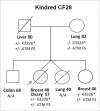Reanalysis of BRCA1/2 negative high risk ovarian cancer patients reveals novel germline risk loci and insights into missing heritability
- PMID: 28591191
- PMCID: PMC5462348
- DOI: 10.1371/journal.pone.0178450
Reanalysis of BRCA1/2 negative high risk ovarian cancer patients reveals novel germline risk loci and insights into missing heritability
Abstract
While up to 25% of ovarian cancer (OVCA) cases are thought to be due to inherited factors, the majority of genetic risk remains unexplained. To address this gap, we sought to identify previously undescribed OVCA risk variants through the whole exome sequencing (WES) and candidate gene analysis of 48 women with ovarian cancer and selected for high risk of genetic inheritance, yet negative for any known pathogenic variants in either BRCA1 or BRCA2. In silico SNP analysis was employed to identify suspect variants followed by validation using Sanger DNA sequencing. We identified five pathogenic variants in our sample, four of which are in two genes featured on current multi-gene panels; (RAD51D, ATM). In addition, we found a pathogenic FANCM variant (R1931*) which has been recently implicated in familial breast cancer risk. Numerous rare and predicted to be damaging variants of unknown significance were detected in genes on current commercial testing panels, most prominently in ATM (n = 6) and PALB2 (n = 5). The BRCA2 variant p.K3326*, resulting in a 93 amino acid truncation, was overrepresented in our sample (odds ratio = 4.95, p = 0.01) and coexisted in the germline of these women with other deleterious variants, suggesting a possible role as a modifier of genetic penetrance. Furthermore, we detected loss of function variants in non-panel genes involved in OVCA relevant pathways; DNA repair and cell cycle control, including CHEK1, TP53I3, REC8, HMMR, RAD52, RAD1, POLK, POLQ, and MCM4. In summary, our study implicates novel risk loci as well as highlights the clinical utility for retesting BRCA1/2 negative OVCA patients by genomic sequencing and analysis of genes in relevant pathways.
Conflict of interest statement
Figures


References
-
- Walsh T, Casadei S, Lee MK, Pennil CC, Nord a. S, Thornton a. M, et al. From the Cover: Mutations in 12 genes for inherited ovarian, fallopian tube, and peritoneal carcinoma identified by massively parallel sequencing. Proc Natl Acad Sci. 2011;108(44):18032–7. doi: 10.1073/pnas.1115052108 - DOI - PMC - PubMed
-
- Antoniou A, Pharoah PDP, Narod S, Risch HA, Eyfjord JE, Hopper JL, et al. Average Risks of Breast and Ovarian Cancer Associated with BRCA1 or BRCA2 Mutations Detected in Case Series Unselected for Family History: A Combined Analysis of 22 Studies. Am J Hum Genet [Internet]. 2003;72(5):1117–30. Available from: http://linkinghub.elsevier.com/retrieve/pii/S0002929707606405 doi: 10.1086/375033 - DOI - PMC - PubMed
-
- Plevová P, Novotný J, Petráková K, Palácová M, Kalábová R, Schneiderová M, et al. Hereditary breast and ovarian cancer syndrome. Klin Onkol. 2009;22 Suppl:S8–11. - PubMed
-
- Peterlongo P, Catucci I, Colombo M, Caleca L, Mucaki E, Bogliolo M, et al. FANCM c.5791C>T nonsense mutation (rs144567652) induces exon skipping, affects DNA repair activity and is a familial breast cancer risk factor. Hum Mol Genet [Internet]. 2015;ddv251. Available from: http://www.hmg.oxfordjournals.org/lookup/doi/10.1093/hmg/ddv251 - DOI - PMC - PubMed
MeSH terms
Substances
Supplementary concepts
Grants and funding
LinkOut - more resources
Full Text Sources
Other Literature Sources
Medical
Research Materials
Miscellaneous

